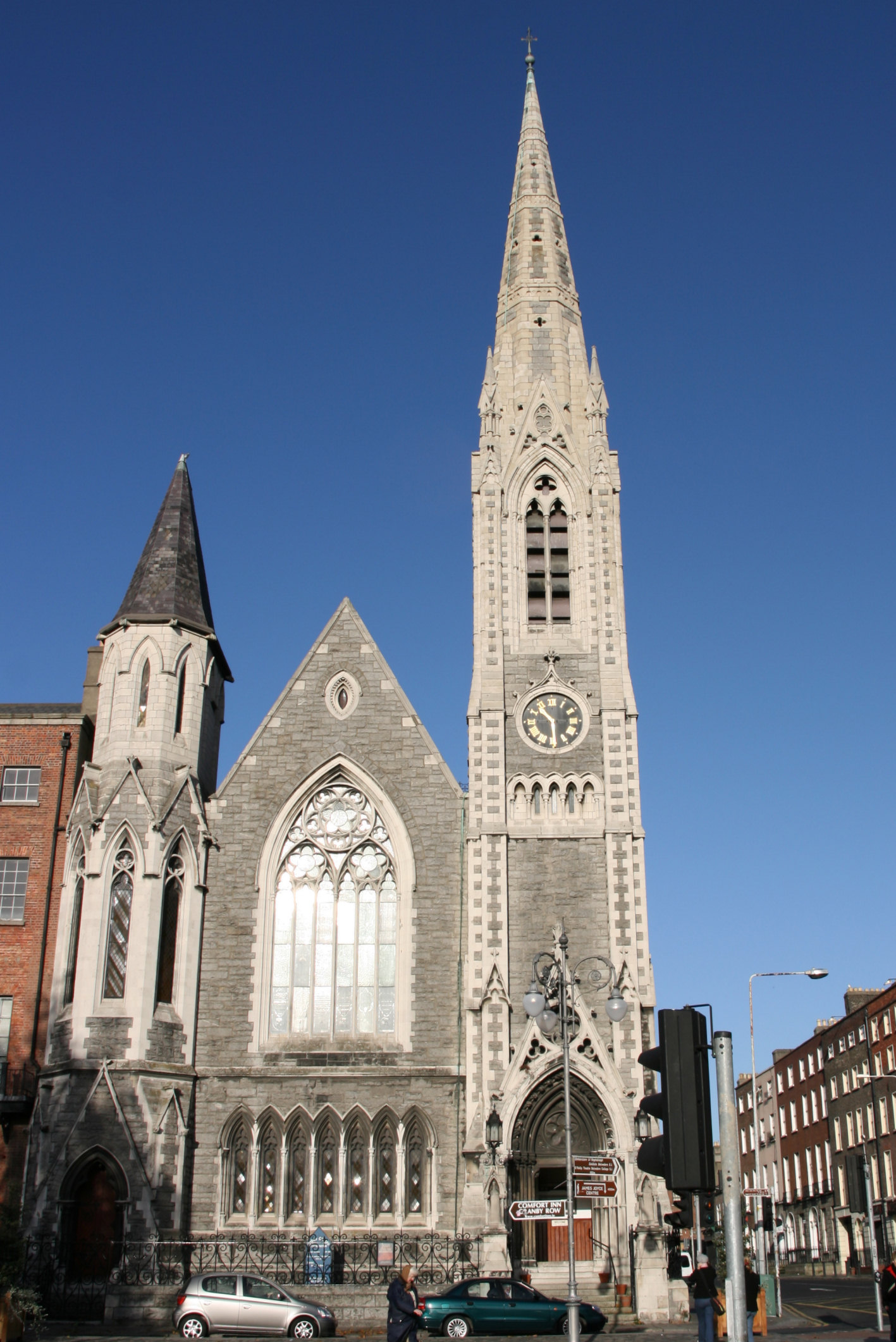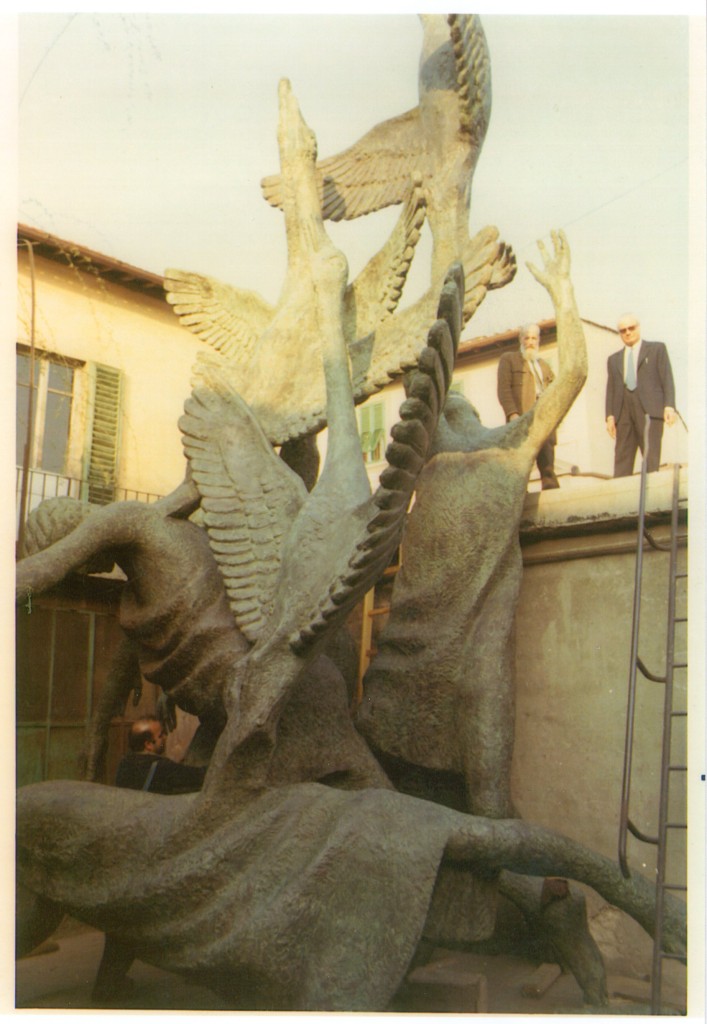|
Semicentennial Of The Easter Rising
The Semi-centennial of the Easter Rising occurred in 1966. Many events took place to mark the Golden Jubilee of the 1916 Easter Rising. Easter Sunday Celebrations began on Easter Sunday on April 10, 1966 when a Military parade took place in Dublin. An estimated 200,000 people attended the march as it paraded down O'Connell Street before stopped outside the General Post Office, the headquarters of the 1916 Easter Rising leaders. The then Irish president Éamon de Valera took the salute with an estimated 900 veterans of the Easter Rising by his side. Later in the day, the president laid a wreath at Kilmainham Gaol, the execution site of the leaders. The museum was officially opened. Easter Monday Religious services were held across the country on Easter Monday in remembrance of the veterans of the Rising. The Garden of Remembrance in Parnell Square was opened by the President and later in the day Radio Éireann presented a live commemorative concert that was held live at the G ... [...More Info...] [...Related Items...] OR: [Wikipedia] [Google] [Baidu] |
Golden Jubilee
A golden jubilee marks a 50th anniversary. It variously is applied to people, events, and nations. Bangladesh In Bangladesh, golden jubilee refers the 50th anniversary year of the separation from Pakistan and is called in Bengali ''"সুবর্ণ জয়ন্তী"'' (''Shuborno jayanti''). Vision 2021 was the political manifesto of the Bangladesh Awami League party before winning the National Elections of 2008. It stands as a political vision of Bangladesh for the year 2021, the golden jubilee of the nation. Several celebration programs will be held in countries including India, Russia, Germany, Sweden, Hungary, Poland, Nepal and Bhutan. China * Emperor Wu of Han dynasty (141-87 BCE, Jubilee in 91 BCE) *Kangxi Emperor of Qing dynasty (1661–1722, Jubilee in 1711) * Qianlong Emperor of Qing dynasty (1735–1796, Jubilee in 1785) Korea *Yeongjo of Joseon (1724-1776, Jubilee in 1774) Japan In Japan, golden jubilee refers to the 50th anniversary and is call ... [...More Info...] [...Related Items...] OR: [Wikipedia] [Google] [Baidu] |
Easter Monday
Easter Monday refers to the day after Easter Sunday in either the Eastern or Western Christian traditions. It is a public holiday in some countries. It is the second day of Eastertide. In Western Christianity, it marks the second day of the Octave of Easter, and in Eastern Christianity it marks the second day of Bright Week. Religious observances Eastern Christianity In the Eastern Orthodox Church and Byzantine Rite Catholic Churches, this day is called "Bright Monday" or "Renewal Monday". The services, as in the rest of Bright Week, are quite different from during the rest of the year and are similar to the services on Pascha (Easter Sunday) and include an outdoor procession after the Divine Liturgy; while this is prescribed for all days of that week, often they are only celebrated on Monday and maybe a couple of other days in parish churches, especially in non-Orthodox countries. Also, when the calendar date of the feast day of a major saint, ''e.g.'', St. George or the ... [...More Info...] [...Related Items...] OR: [Wikipedia] [Google] [Baidu] |
Irish Historical Anniversaries
Irish may refer to: Common meanings * Someone or something of, from, or related to: ** Ireland, an island situated off the north-western coast of continental Europe ***Éire, Irish language name for the isle ** Northern Ireland, a constituent unit of the United Kingdom of Great Britain and Northern Ireland ** Republic of Ireland, a sovereign state * Irish language, a Celtic Goidelic language of the Indo-European language family spoken in Ireland * Irish people, people of Irish ethnicity, people born in Ireland and people who hold Irish citizenship Places * Irish Creek (Kansas), a stream in Kansas * Irish Creek (South Dakota), a stream in South Dakota * Irish Lake, Watonwan County, Minnesota * Irish Sea, the body of water which separates the islands of Ireland and Great Britain People * Irish (surname), a list of people * William Irish, pseudonym of American writer Cornell Woolrich (1903–1968) * Irish Bob Murphy, Irish-American boxer Edwin Lee Conarty (1922–1961) * Irish McCal ... [...More Info...] [...Related Items...] OR: [Wikipedia] [Google] [Baidu] |
Ten Shilling Coin
The ten shilling (10s) ( ga, deich scilling) coin was a one-off commemorative coin issued in Ireland in 1966 to mark the 50th anniversary of the Easter Rising. Ten shillings was a subdivision of the pre-decimal Irish pound, worth of an Irish pound, making this the highest-value coin in the pre-decimal system. The coin was 83.1/3% silver and 16.2/3% copper. It measured in diameter and weighed 18.144 grams, therefore containing of silver. The coin did not prove popular, and 1,270,000 of the two million produced were withdrawn and melted down. This unpopularity may be due to the ten shilling Series A Banknote which was then in circulation. Twenty thousand coins were issued as proofs in green boxes. The reverse design featured the death of Cú Chulainn, the mythical Irish hero, who is seen tied to a stone and with a raven on his shoulder. The figure of Cú Chulainn is a miniature of the statue by Oliver Sheppard, in the General Post Office, Dublin. The coin was produced for the ... [...More Info...] [...Related Items...] OR: [Wikipedia] [Google] [Baidu] |
Commemorative Coins Of Ireland
Various commemorative coins denominated in Irish currency were issued until 2002, when the Irish pound (IEP/IR£) came to an end and was superseded by the euro. Since then there have been Irish commemorative coins denominated in euro. Irish pound Silver ten-shilling piece (1966) Dublin Millennium 50p (1988) UN anniversary pound coin (1995) Millennium pound coin (2000) European Currency Unit (ECU) See also * Euro gold and silver commemorative coins (Ireland) References # # {{Euro coins (collectors edition) Commemorative coins Ireland Ireland ( ; ga, Éire ; Ulster-Scots: ) is an island in the North Atlantic Ocean, in north-western Europe. It is separated from Great Britain to its east by the North Channel, the Irish Sea, and St George's Channel. Ireland is the s ... Ireland-related lists ... [...More Info...] [...Related Items...] OR: [Wikipedia] [Google] [Baidu] |
Gaiety Theatre, Dublin
The Gaiety Theatre is a theatre on South King Street in Dublin, Ireland, off Grafton Street and close to St. Stephen's Green. It specialises in operatic and musical productions, with occasional dramatic shows. History In April 1871, the brothers John and Michael Gunn obtained a 21-year license to establish "a well-regulated theatre and therein at all times publicly to act, represent or perform any interlude, tragedy, comedy, prelude, opera, burletta, play, farce or pantomime". In favour of the Gunn's license application was that, unlike the existing theatres, they were not proposing to promote local drama which had acquired something of a reputation with the Dublin Castle administration for stirring up nationalist sentiments. The city centre site in King Street was 17 metres wide on King Street and 42 metres deep towards Tangier Lane. The Gunns employed the experienced theatre architect Mr C.J. Phipps, One of the theatres Philips had recently completed in 1868 in London was ... [...More Info...] [...Related Items...] OR: [Wikipedia] [Google] [Baidu] |
RTÉ Radio
RTÉ Radio is a division of the Irish national broadcasting organisation Raidió Teilifís Éireann. RTÉ Radio broadcasts four analogue channels and five digital channels nationwide. Founded in January 1926 as 2RN, the first broadcaster in the Irish Free State, in 1933 the service became Radio Athlone (Irish ''Raidió Áth Luain'') and in 1938 was renamed as Radio Éireann. In 1966, after launching a television service, it became Raidió Teilifís Éireann, or RTÉ. RTÉ Radio is, like its television parent, a statutory body, overseen by a board appointed by the Government of Ireland, with general management in the hands of the RTÉ Executive Board, headed by the Director-General. RTÉ Radio is regulated by the Broadcasting Authority of Ireland. Channels and availability History The first voice broadcast of 2RN, the original radio callsign for what would eventually become RTÉ Radio 1, took place on 14 November 1925 when Seamus Clandillon, the station director, announc ... [...More Info...] [...Related Items...] OR: [Wikipedia] [Google] [Baidu] |
Parnell Square
Parnell Square () is a Georgian square sited at the northern end of O'Connell Street in the city of Dublin, Ireland. It is in the city's D01 postal district. Formerly named ''Rutland Square'', it was renamed after Charles Stewart Parnell (1846–1891), as was Parnell Street, which forms the southern side of the square. Surrounded on three sides by terraces of original intact Georgian houses, much of the southern part of the square and its centre is taken up by extensions of the Rotunda Hospital while the Garden of Remembrance is located along the northern side of this area. The main entrance to the Garden of Remembrance is on the eastern side of the square, with a smaller entrance on the northern side of the square. Notable buildings on the square The Gate Theatre and the Ambassador and Pillar Room venues are located at the southeastern corner of the square, where it meets O'Connell Street. Entertainments were originally developed here as part of the Rotunda Hospital scheme ... [...More Info...] [...Related Items...] OR: [Wikipedia] [Google] [Baidu] |
Garden Of Remembrance (Dublin)
The Garden of Remembrance ( ga, An Gairdín Cuimhneacháin) is a memorial garden in Dublin dedicated to the memory of "all those who gave their lives in the cause of Irish Freedom". It is located in the northern fifth of the former Rotunda Gardens in Parnell Square, a Georgian square at the northern end of O'Connell Street. The garden was opened by Eamon de Valera during the semicentennial of the Easter Rising in 1966. Commemoration The Garden commemorates freedom fighters from various uprisings, including: * the 1798 rebellion of the Society of United Irishmen * the 1803 rebellion of Robert Emmet * the 1848 rebellion of Young Ireland * the 1867 rising of the Fenian Brotherhood * the 1916 Easter Rising of the Irish Volunteers and the Irish Citizen Army * the 1919–21 Irish War of Independence of the Irish Republican Army The site of the Garden is where the Irish Volunteers were founded in 1913, and where several leaders of the 1916 Rising were held overnight before ... [...More Info...] [...Related Items...] OR: [Wikipedia] [Google] [Baidu] |
Kilmainham Gaol
Kilmainham Gaol ( ga, Príosún Chill Mhaighneann) is a former prison in Kilmainham, Dublin, Ireland. It is now a museum run by the Office of Public Works, an agency of the Government of Ireland. Many Irish revolutionaries, including the leaders of the 1916 Easter Rising, were imprisoned and executed in the prison by the orders of the UK Government. History When it was first built in 1796, Kilmainham Gaol was called the "New Gaol" to distinguish it from the old prison it was intended to replace – a noisome dungeon, just a few hundred metres from the present site. It was officially called the ''County of Dublin Gaol'', and was originally run by the Grand Jury for County Dublin. Originally, public hangings took place at the front of the prison. However, from the 1820s onward very few hangings, public or private, took place at Kilmainham. A small hanging cell was built in the prison in 1891. It is located on the first floor, between the west wing and the east wing. There w ... [...More Info...] [...Related Items...] OR: [Wikipedia] [Google] [Baidu] |
Easter Rising
The Easter Rising ( ga, Éirí Amach na Cásca), also known as the Easter Rebellion, was an armed insurrection in Ireland during Easter Week in April 1916. The Rising was launched by Irish republicans against British rule in Ireland with the aim of establishing an independent Irish Republic while the United Kingdom was fighting the First World War. It was the most significant uprising in Ireland since the rebellion of 1798 and the first armed conflict of the Irish revolutionary period. Sixteen of the Rising's leaders were executed from May 1916. The nature of the executions, and subsequent political developments, ultimately contributed to an increase in popular support for Irish independence. Organised by a seven-man Military Council of the Irish Republican Brotherhood, the Rising began on Easter Monday, 24 April 1916 and lasted for six days. Members of the Irish Volunteers, led by schoolmaster and Irish language activist Patrick Pearse, joined by the smaller Irish Citizen Arm ... [...More Info...] [...Related Items...] OR: [Wikipedia] [Google] [Baidu] |
Wreath
A wreath () is an assortment of flowers, leaves, fruits, twigs, or various materials that is constructed to form a circle . In English-speaking countries, wreaths are used typically as household ornaments, most commonly as an Advent and Christmas decoration. They are also used in ceremonial events in many cultures around the globe. They can be worn as a chaplet around the head, or as a garland around the neck. Etymology The word ''wreath'' comes from Middle English ''wrethe'' and from Old English ''writha'' 'band'. History Ancient Etruscan wreaths Wreaths were a design used in ancient times in southern Europe. The most well-known are pieces of Etruscan civilization jewelry, made of gold or other precious metals. Symbols from Greek myths often appear in the designs, embossed in precious metal at the ends of the wreath. Ancient Roman writers referred to Etruscan ''corona sutilis'', which were wreaths with their leaves sewn onto a background. These wreaths resemble a ... [...More Info...] [...Related Items...] OR: [Wikipedia] [Google] [Baidu] |

.jpg)





